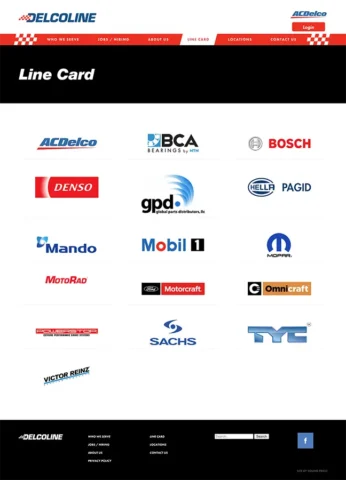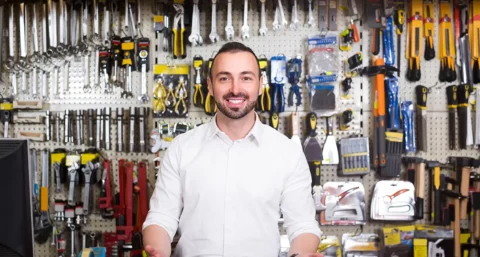Here are three strategic areas that are critical for automotive distributors. Two of these are people related. One is related to procurement and marketing. We’ll do that first.
#1 Your Line Card
Some of our distributor clients have had the same line card for decades. Others have changes and additions because they are watching business and bringing on and removing lines. You know your market and what sells, but what you don’t always know is what new things your customers may be looking for. You can ask them. Send them a survey, find out what part categories they’d like to see more of from you.
When you add a new line, don’t take on more than you should. Some manufacturers want you to “take it all” but just consider what that inventory is going to do on your shelves. Promote your Line Card, make sure it’s easy to get to. Have links to those manufacturer websites. Show your Line Card by product category as well. And promote the brands and manufacturer partners you should promote. Get their product fliers and have them in your buying portals. If you haven’t looked at your Line Card in a while, take a look at it to see what changes you may have already made. Sound Press can help you with all this. We work for automotive distributors all over North America.
#2 Talent Retention
It’s tough to come in and find out you’ve got 1 or 2 people out for some reason. If you’re the GM or even the owner, chances are your day just got really busy. In Automotive Parts Distribution, keeping or retaining your talent is not just going to happen without action. You need to pay attention to this.
Here are 5 quick strategies to help retain employees in automotive distribution.
- Create clear career advancement pathways. Develop structured career ladders that show employees how they can progress within your organization. This might include paths from warehouse associates, drivers, and forklift operators, to team leads, inventory specialists, logistics coordinators, and management positions. Provide regular training and certification opportunities related to automotive knowledge and supply chain operations.
- Implement competitive compensation packages with industry-specific benefits. Beyond competitive wages, consider benefits that address unique industry challenges like tuition reimbursement for automotive technology courses, tool allowances, company vehicle programs, or discounts on automotive parts and services. Performance-based incentives tied to distribution metrics can also drive motivation.
- Foster a safety-focused, positive workplace culture. Prioritize safety protocols, provide proper equipment, and recognize safe behavior. Create a positive environment where automotive knowledge is valued and employee input on improving distribution processes is actively sought. Make sure all employees feel empowered and safe to say when something is not safe or needs to be addressed.
- Offer flexible scheduling where possible. Consider implementing shift options that allow employees some control over their schedules. This might include compressed workweeks (four 10-hour days), shift-swapping capabilities, or partial remote work for administrative roles.
- Recognize expertise and specialized knowledge. Automotive distribution requires specific product knowledge and technical understanding. Create recognition programs that acknowledge employees who develop expertise in vehicle systems, parts identification, inventory management, or other specialized areas. This validates their professional development and encourages others to expand their automotive knowledge.
#3 Customer Experience
Your customers are likely fleet managers, parts departments at dealerships, repair shop managers, service technicians and the like. Make sure your team treats all customers with some level of personal touch, preserving good relationships, and trying to over deliver on service, and even fulfillment.
Here are 3 strategies for better customer experience in automotive parts distribution
- Implement a comprehensive digital inventory and ordering system. Create a user-friendly online platform where customers can check real-time inventory status, place orders, track shipments, and access their purchase history. Include features like vehicle-specific part compatibility tools, cross-referencing capabilities, and automated reordering options. For service technicians, add technical diagrams and installation guides. For fleet managers, develop bulk ordering functions and usage reports to help them track parts consumption across their fleet.
- Provide specialized technical support and training. Establish a dedicated technical support team staffed by automotive experts who can assist with part identification, troubleshooting, and application questions. Offer regular training sessions on new vehicle technologies, changing parts specifications, and emerging automotive trends. For dealership parts departments, provide inventory management best practices. For repair shops, offer clinics on diagnosing complex systems or working with new vehicle technologies.
- Develop customized delivery and logistics solutions. Create tiered delivery options including emergency/same-day service for critical repairs, scheduled delivery routes, and after-hours pickup options. For fleet customers, establish dedicated inventory spaces in your warehouse for their commonly used parts. For service technicians and repair shops, offer delivery timing that aligns with their bay scheduling to minimize vehicle downtime. Consider implementing specialized packaging to protect sensitive parts and organized delivery systems that match parts to specific work orders.
Some of these topics are just from our experience working in Automotive Marketing for Distributors and Manufacturers since 2004. Sound Press doesn’t necessarily do programs like “career advancement pathways”. But we’ve worked with a lot of companies and consultants that do all of these things. Reach out if you need help or want to talk about how we might be able to help, and keep your eye on these topics. We hope this is helpful for your business.
-Adam Smith, President



